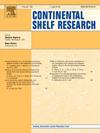Residual flow in a deglaciated coastal bay with low freshwater input
IF 2.2
3区 地球科学
Q2 OCEANOGRAPHY
引用次数: 0
Abstract
The drivers of the tidal and residual flows in estuaries can vary spatially and temporally due to geomorphic complexities, fortnightly tides, and climatic influences. In this paper, we explore the mechanisms that give rise to the circulation patterns in Frenchman Bay, Maine, on the Eastern Coast of the USA, under varying freshwater input conditions and fortnightly tidal phases, using idealized simulations from a high-resolution, three-dimensional numerical model. The results of the simulations at the tidal timescale reveal a tidal asymmetry in vorticity, where vorticity generated during flood tide is not spun-down during the subsequent ebb. This asymmetry prompts the investigation of the residual circulation in the bay which is characterized by large tidal residual eddies. These eddies are found to persist in the depth-averaged residual flow regardless of the freshwater input or tidal phase, leading to the conclusion that the eddies are “geomorphically-constrained” in the bay. Analysis of the horizontal momentum terms and a simulation performed without Coriolis forcing demonstrates that the tidal stress terms predominantly balance the barotropic pressure gradient to give rise to the eddy patterns, while the Coriolis force acts to strengthen their vorticity. The eddies create a laterally sheared residual flow structure with depth, however the flow is more vertically sheared during the neap tide when the baroclinic pressure gradient plays a larger role. These findings demonstrate the persistence of tidal residual eddies regardless of freshwater input or fortnightly tidal phase in a geomorphically complex deglaciated coastal bay with low freshwater input.
低淡水输入的消冰海岸海湾的剩余流量
由于地形的复杂性、两周潮汐和气候的影响,河口潮汐和剩余流量的驱动因素在空间和时间上都是不同的。在本文中,我们利用高分辨率三维数值模型的理想模拟,探讨了美国东海岸缅因州法国湾在不同淡水输入条件和两周潮汐相下产生环流模式的机制。在潮汐时标上的模拟结果揭示了涡度的潮汐不对称性,即在涨潮时产生的涡度在随后的退潮时不会被旋降。这种不对称性促使人们对海湾中以大的潮汐残余涡流为特征的残余环流进行研究。研究发现,无论淡水输入或潮汐相如何,这些涡流在深度平均剩余流中都持续存在,从而得出涡流在海湾中受到“地貌约束”的结论。对水平动量项的分析和在没有科里奥利力的情况下进行的模拟表明,潮汐应力项主要平衡正压梯度以产生涡旋型,而科里奥利力则加强了它们的涡度。小潮期间,斜压梯度作用较大,涡流形成横向剪切的深度残余流结构,而小潮期间,斜压梯度作用较大,残余流的纵向剪切作用更大。这些发现表明,在一个地形复杂、淡水量少、冰川消退的海岸海湾,无论淡水输入与否,潮汐残余涡流都是持续存在的。
本文章由计算机程序翻译,如有差异,请以英文原文为准。
求助全文
约1分钟内获得全文
求助全文
来源期刊

Continental Shelf Research
地学-海洋学
CiteScore
4.30
自引率
4.30%
发文量
136
审稿时长
6.1 months
期刊介绍:
Continental Shelf Research publishes articles dealing with the biological, chemical, geological and physical oceanography of the shallow marine environment, from coastal and estuarine waters out to the shelf break. The continental shelf is a critical environment within the land-ocean continuum, and many processes, functions and problems in the continental shelf are driven by terrestrial inputs transported through the rivers and estuaries to the coastal and continental shelf areas. Manuscripts that deal with these topics must make a clear link to the continental shelf. Examples of research areas include:
Physical sedimentology and geomorphology
Geochemistry of the coastal ocean (inorganic and organic)
Marine environment and anthropogenic effects
Interaction of physical dynamics with natural and manmade shoreline features
Benthic, phytoplankton and zooplankton ecology
Coastal water and sediment quality, and ecosystem health
Benthic-pelagic coupling (physical and biogeochemical)
Interactions between physical dynamics (waves, currents, mixing, etc.) and biogeochemical cycles
Estuarine, coastal and shelf sea modelling and process studies.
 求助内容:
求助内容: 应助结果提醒方式:
应助结果提醒方式:


